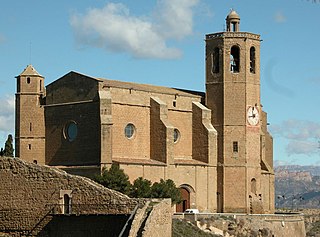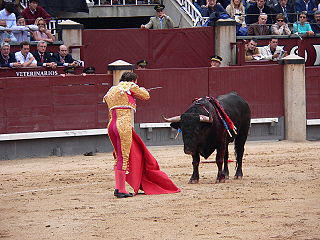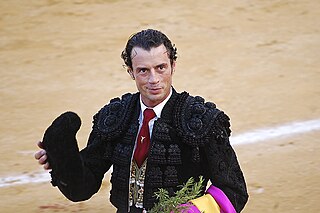
Balaguer is the capital of the comarca of Noguera, in the province of Lleida, Catalonia, Spain. It is located by the river Segre, a tributary to the Ebro. The municipality includes an exclave to the east. Balaguer also has a sister city in the western United States, Pacifica, California.

The Plaza de Toros de Las Ventas, known simply as Las Ventas, is the largest bullfighting ring in Spain, located in the Guindalera quarter of the Salamanca district of Madrid. It was inaugurated on June 17, 1931. Its seating capacity of 23,798, makes it the third-largest bullfighting run in the world, after bullrings in Mexico and Venezuela. After the federal ban of bulfighting in Plaza México, Las Ventas is the second largest bullring in the world still in operation for its original intention.

A bullring is an arena where bullfighting is performed. Bullrings are often associated with the Iberian Peninsula, but they can also be found through Iberian America and in a few Spanish and Portuguese ex-colonies in Africa. Bullrings are often historic and culturally significant centres that bear many structural similarities to the Roman amphitheatre.

Francisco Rivera Pérez, better known as Paquirri, was a Spanish bullfighter. He died after being gored by a bull named Avispado at the Pozoblanco bullring. During his career, he was six times borne shoulder-high out through the Great Gate at Las Ventas.

Plaza Monumental de toros de Pueblo Nuevo is a Bullring in San Cristóbal, Venezuela, currently used for bullfighting. The stadium can hold up to 15,000 people and was built in 1967.
Neo-Mudéjar is a type of Moorish Revival architecture practised in the Iberian Peninsula and to a far lesser extent in Ibero-America. This architectural movement emerged as a revival of Mudéjar style. It was an architectural trend of the late 19th and early 20th centuries that began in Madrid and Barcelona and quickly spread to other regions in Spain and Portugal. It used Mudéjar style elements such as the horseshoe arch, arabesque tiling, and abstract shaped brick ornamentations for the façades of modern buildings.

Metrovacesa S.A. is a major Spanish property company, headquartered in Madrid, which was the largest publicly traded real estate developer in the Eurozone. The company is primarily focused on the leasing of a range of property in France and Spain, which comprises around 80% of its portfolio.

La Nova Esquerra de l'Eixample is a neighborhood in the Eixample district of Barcelona, Catalonia (Spain). Originally it formed a single unit, called Esquerra de l'Eixample, with the current neighborhood l'Antiga Esquerra de l'Eixample.

Bullfighting is a physical contest that involves a bullfighter attempting to subdue, immobilize, or kill a bull, usually according to a set of rules, guidelines, or cultural expectations.
Bullfighting was banned in the Spanish autonomous community of Catalonia by a vote of the Catalan Parliament in July 2010. The ban came into effect on 1 January 2012. The last bullfight in the region took place on 25 September 2011 at La Monumental. The ban was officially annulled for being unconstitutional by Spain's highest court on 5 October 2016. However, despite the overturning of the ban, no further bullfight had taken place in Catalonia as of July 2020.

The Plaza de Toros Monumental de Barcelona, often known simply as La Monumental, is a bullring in the city of Barcelona, Catalonia, Spain. It was the last bullfighting arena in commercial operation in Catalonia. It was inaugurated in 1914 under the name Plaza de El Sport and was soon expanded and given its current name in 1916. It is situated at the confluence of the Gran Via and Carrer Marina in the Eixample district. It has a capacity of 19,582 within 26 rows of lines, boxes, and stands on the first floor inside and an upper gallery surrounding the building.
Miguel Báez Espuny, better known as "El Litri", was a Spanish bullfighter, a descendant of one of Huelva's foremost bullfighting dynasties.

Societat Civil Catalana is a Spanish unionist organization based in Barcelona. Launched in 2014, SCC seek to counter the Catalan independence movement.

Teresa Pàmies Bertran was a Spanish Catalan-language writer.

The Plaza de Toros de Pontevedra (Spain) is the bullring of the Spanish city of Pontevedra and the only one in the autonomous community of Galicia. It has a capacity of 7,800 spectators and is classified as the second category of Spanish bullring. The current bullring replaced a wooden one dating from 1892, although the tradition of bullfighting in Pontevedra dates back to the 17th century.

Fuengirola Bullring is a 3rd category bullring located in Fuengirola, a coastal town in the province of Málaga, part of the autonomous community of Andalusia, Spain. The plaza is known for hosting traditional bullfights, as well as other cultural and entertainment events, such as concerts, theatrical performances, and exhibitions. It serves as an important venue for cultural exchange and a symbol of Spanish tradition and history.

Juan Serrano Pineda, better known as Finito de Córdoba, is a Spanish bullfighter. He has exited through Las Ventas' Puerta Grande on one occasion.
Andrés Mazariegos Vázquez, known professionally as Andrés Vázquez "El Nono", was a Spanish bullfighter. Among his influences in tauromachy were Juan Belmonte, Domingo Ortega and Antonio Bienvenida. He was awarded the Order of Beneficence in 1975, and ten times he came out of the Great Gate at Las Ventas. He had great success fighting bulls from the Victorino ranch.

Francisco Camino Sánchez, known in the bullfighting world as Paco Camino, was a Spanish bullfighter and bull breeder. A bullfighter of the highest order, he dominated tauromachy and was twelve times borne shoulder-high out through the Great Gate at Las Ventas in Madrid, a record bested only by Santiago Martín Sánchez.
Jesús Martínez Barrios, known as Morenito de Aranda is a Spanish bullfighter. Born in a small town in Burgos, he had no family background in bullfighting, but has nonetheless become a well known matador in his own country and abroad. His interests also extend to raising the very cattle that he fights at a farm that he established.
















